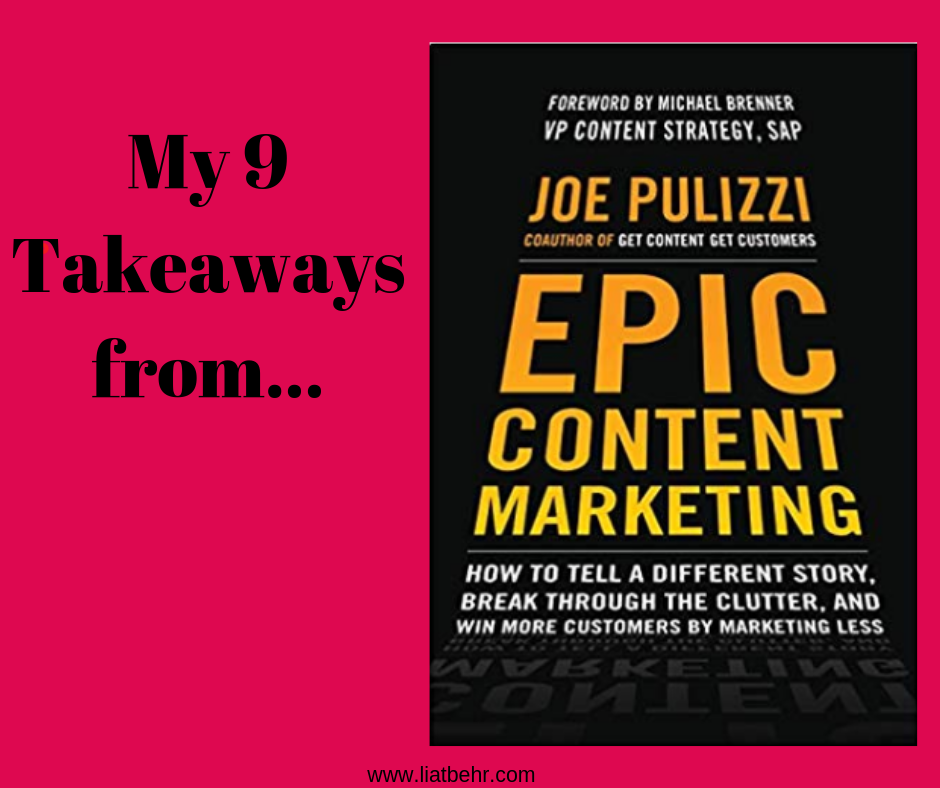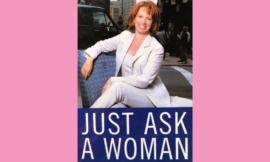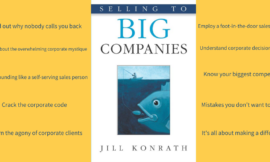I’m an avid reader. I’m usually reading 6 or 7 books simultaneously – a mix of traditional books, a Kindle book and an Audible book. But I digress. My point is not to tell you how much I read; it’s to tell you about Epic Content Marketing by Joe Pulizzi, which is one of the best books on content that I have ever read. Really.
While there are way too many takeaways for me to discuss in this short blog post, here are 9. And I hope you find them as valuable as I do:
-
“Content marketing is owning media as opposed to renting it.”
I never quite thought about it this way. Having my own blog means I need to own my media in every sense of the word. So while we live in a SAAS world and we’re used to subscribing to services, it means that we don’t really have to own anything in this world of abundance. But owning content is important because if all we’re doing is posting content on Facebook instead of a blog, we’re making Facebook into the owner of our content. Instead, we need to constantly and consistently be creating content that is posted on our own channel with the goal of changing and enhancing consumer behaviour. And It’s through our content that we have the ability to not only tell our consumers that we know our stuff, but also building trust that will ultimately turn prospects into paying customers.
-
The Business Model of Content Marketing
This is the name of chapter four in the book, and it’s one of my favorite chapters. Because I’ve always been really curious about the different models and possibilities. The chapter outlines the basic media business model, pointing out four different ways to deliver content (a non-exhaustive list):
Web content, webinars, in-person events and print advertising.
And then goes on to give the fabulous example of the LEGO company and how it’s built itself into a content giant. And while most of us have limited resources, we all have the possibility to engage with our customers (and prospective customers) on our own terms.
-
Content strategy is a personal statement
Our content strategy is a personal statement that combines our business objectives with the information needs of our target audience. And while that means that our content marketing initiative is a waltz that must take into account both our needs and the needs of our partner (our prospective client), we must first and foremost constantly think about our partner and how we’re going to solve her needs. And of course, it’s vital that we understand that our content has to take the job of not only answering her questions, but that it also does so in a way that is engaging and even entertaining.
For me, this point comes up every time I create a new piece of content whether it’s for my blog or for a new client. I constantly tell myself that ‘I am only as good as my next piece of content.’ This helps me stay grounded in my work and thinking about my client and how I’m going to solve her needs. Every piece of work we put out into the world is a personal statement. And we are here to serve.
-
Our content marketing mission statement
Have you ever seen Simon Sinek’s TED talk “How Great Leaders Inspire Action?” His point, after some very compelling illustrations, is that before we ask “what” we must ask “why.” And that’s exactly the point of a marketing mission statement (or any mission statement, for that matter).
Our mission statement answers our why – the reason we must exist. Because it is only when we truly understand our purpose that we can have impact.
-
The editorial calendar also needs a styling guide
I have tried so many versions of an editorial calendar and still have not found anything I’m entirely happy with. But what I understood is that I’m not even close to having exhausted my options – Pulizzi mentions a number of tools that I haven’t yet tried. If you have a blog, you know that an editorial calendar is a must. But that’s not enough. In addition to having an editorial calendar, we need to have a styling guide. A styling guide is where we write down the rules of our brand in terms of voice, type of content, products, the colours, et al.
To me this relates to something I once heard on the Science of Success podcast – have systems in place. Sometimes we’re influenced by things that happen externally, and these seem to make complete sense, but having a system in place for how to do things can keep us on target and save us a lot of trouble in the long run.
-
View information as the product
To create information as the product means we’ve got to go to great lengths to make it something really spectacular. In Pulizzi’s words – epic. As media publishers, we’re in competition with all those other messages racing for our target audience’s attention. So if we expect to win, we have to produce content that our target audience cares about immensely. And this where story comes in and why it is so important. Our target audience’s pain points matter and it’s up to us to build it into a narrative that they care about. If prospects won’t care about our content, we’re dead in the water. So before starting any content project think about its value as a product.
This is an approach that I love. Especially when I think about LEGO. The LEGO company created a full-length film, which if we think about it, is nothing more than a two-hour commercial. The information is the product. And it’s genius, when it’s done right.
-
Identifying our content assets
Think about your content assets as a type of property that is high in value – or that has the potential to have high value. Pulizzi recommends conducting an audit to find your assets. This includes gathering together all your marketing content, identifying which pieces of content people will share, talking about it and rating it. There’s a lot of work involved in the process and more details in the book about how to practically approach a content audit, but it will pay off, because by the end of process you’ll have “updated, organized and relevant” content.
-
Putting a content plan in action
The following components are what we need before putting any content plan into action:
- Channel – a core channel (e.g. blog)
- Persona – identifying the target audience (e.g. senior marketing executives)
- Content goal – being clear on our goals for channel and content
- Primary content type – blog post, videos infographics, e-book
- Structure – how the content is built (e.g. 500 word blog post with multiple headings and bullet points
- Tone – tone of voice (e.g. serious, playful)
- Channel integration – integrating channels for greater leverage (e.g. for video – integrating with YouTube and embed into a blog post)
- Desired action – measuring metrics (e.g. number of subscribers, e-book downloads)
- Editorial plan – leveraging our editorial calendar to ensure we consistently deliver the right story to our target audience
-
Content promotion
This is probably one of the hardest things for me and where I really need to get better. Creating the content isn’t hard for me. I love what I write about, I’m passionate about the content and about delivering value to my target audience. What I get wrong is – it’s not about me. if I’ve made the tremendous effort to write great content for my audience, it’s vital that I make sure they now about it. It’s all about my target audience.
Here are some alternative content promotion techniques I hope to be implementing asap:
- Creating a “hit list” of keywords
- Finding a community that might be interested in syndicating our original content on their site – Joe Pulizzi’s company, CMI does this with Business2Community.com
- Reimagine content in ten different ways – take parts of a blog post and turn it into an image to share on Pinterest, a tweet, FB post, et al
- Adding images to everything – for me this means going back to old blog posts and making sure they have images
- Commenting on blogs – I thought this was dead, and maybe it doesn’t necessarily have to be blogs – it can be posting on a LinkedIn post, Instagram post or anywhere your key inspirational people are sharing their content. The point is, discover the blogs or key people in your industry, learn from them and engage with them.
Which takeaway makes you want to learn more? Did I convince you that you need to read Epic Content Marketing?



